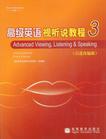高级英语视听说教程
出版时间:2005-11 出版社:高等教育出版社 作者:本社 页数:137 字数:230000
Tag标签:无
前言
近年来,加强听力教学,帮助学习者提高听力已成为国际英语教学的重点之一。其原因在于无论是学习母语还是学习外语,都要首先培养学习者的听力。教育部2004.年颁布的《大学英语课程教学要求(试行)》的培养目标中指出,注重培养学生英语综合应用能力,特别是听说能力。在“听力”技能培养中还提出:1)能基本听懂英语国家人士的谈话和讲座,2)能听懂题材熟悉、篇幅较长的国内英语广播或电视节目,掌握大意,3)能基本听懂外国专家用英语讲授的专业课程。再如《高等学校英语专业英语教学大纲》(2000)在规定结业时所应达到“听”的能力时指出:.1)听懂真实交际场合中各种英语会话;2)听懂英语国家广播电台以及电视台有关政治、经济、文化、教育、科技等方面的专题报道以及与此类题材相关的演讲;3)听懂电视时事报道和电视剧中的对话等。许多语言教学工作者也指出,听力教学应是其他语言技能教学的基础,只有解决了学习者“听”的问题,才能更有效地解决“说”的问题。 为提高大学生的英语听说能力,使其达到《大学英语课程教学要求(试行)》中规定的较高要求和更高要求,高等教育出版社引进了美国汤姆森学习集团公司2005年一2006年最新出版的中高级英语听力教程1~3册,并组织国内高校专家和教师改编为《高级英语视听说教程》l~3册。这套教材主要是通过观看视频讲座或听录音,训练学习者的英语听力技巧,提高学习者听力理解能力,提高学习者听学术讲座的记录能力,提高学生就相关主题的口头表达能力。 本书是第三册,共5个单元,每单元2章。每章由听前部分【Prelistening)、听中部分(IAstening)、听后部分(Postlistening)和阅读扩展(ReadingExpansion)组成。这些练习集中训练学习者的听力、记录、口语以及阅读理解能力。教材内容涉及人类学(Anthropology)、历史学《}1istory)、社会学(Sociology)、交流(Communication)、生物学【Biology)等方面,材料丰富、充实。 该教材适用于大学英语本科高级听说课程,特别是高级选修课程、研究生英语课程及同等水平的培训课程,如托福、雅思考试培训等。本书配有学生用书、教师用书、课堂教学DVD/MP3和磁带。 建议教师和学生在学习第三册教材之前,先预习书后的生词表。 高等教育出版社 2005年7月
内容概要
《高级英语视听说教程3(引进改编版)》是其中的第三册,共5个单元,每单元2章。每章由听前部分、听中部分、听后部分和阅读扩展组成。这些练习集中训练学习者的听力、记录、口语以及阅读理解能力。教材内容涉及人类学、历史学、社会学、交流、生物学等方面,材料丰富、充实。为提高大学生的英语听说能力,使其达到《大学英语课程教学要求(试行)》中规定的较高要求和更高要求,高等教育出版社引进了美国汤姆森学习集团公司2005年一2006年最新出版的中高级英语听力教程1~3册,并组织国内高校专家和教师改编为《高级英语视听说教程》1~3册。这套教材主要是通过观看视频讲座或听录音,训练学习者的英语听力技巧,提高学习者听力理解能力,提高学习者听学术讲座的记录能力,提高学生就相关主题的口头表达能力。
书籍目录
Unit One Anthropo1ogy:The Evo1ution of Human Endeavor
Chapter 1 Anthropo1ogy:The Study of Human Beings and Their
Creations
Chapter 2 The Concept of Cu1ture:Understanding One Another
Unit Two History:The Passing of Time and Civi1izations
Chapter 3 The Egyptian Pyramids:Houses of Eternity
Chapter 4 The First Emperor of China:Bui1ding an Empire and a
House of Eternity
Unit Three Socio1ogy:Women, Men, and Changing Ro1es
Chapter 5 The Womens Movement:From 1iberation to Feminism
Chapter 6 The Mens Movement:What Does It Mean to Be a Man?
Unit Four Communication:The Inf1uence of 1anguage, Cu1ture, and
Gender
Chapter 7 C1assroom Communication:1anguage and Cu1ture in the
C1assroom
Chapter 8 Gender and Communication:Ma1e-Fema1e Conversation as
Cross-cu1tura1 Communication
Unit Five Bio1ogy:Understanding Genetics to Genetic
Engineering
Chapter 9 The Origins of Genetics:Mende1 and the Garden Pea
Experiment
Chapter 10 Genetic Engineering in the Biotech Century:P1aying It
Smart or P1aying Rou1ette with Mother Natures Designs?
G1ossary
章节摘录
By Caryl Rivers Happy Fathers Day, Men of America. Are you the Sensitive Male, the Post-SensitiveMale, the Involved Dad, the Macho Man, the Neo-wimp or the Terminator? Confused about the crisis of masculinity in con-temporary society? Do you fail to recognize yourselfin all the images of manhood bandied about, fromthe shirtless sex symbol in the Diet Coke ad to theangst-ridden family men in re-runs of "Thirtysome-thing" to the cheerless killing machines of theaction-adventure flicks? Do you long for the good old days, when menwere men and guys didnt have to worry aboutwho——or what——they were?It may be some consolation to know this confu-sion is nothing new. The crisis of masculinity is nota novel historical phenomenon, created by thewomens movement or economic downsizing ormodern urban life. In fact, the crisis of masculinity is as American asapple pie.Teddy Roosevelt worried about it. So didHenry James. One can imagine Natty Bumpo, sitting on a log inhis deerskins, wondering whether the Iroquois hadthe manhood thing right, and if he had to scurry tocatch up. Every historical era, in fact, seems to have beenconflicted over the correct definition of manhood——-and whatever it was, people were sure men didnthave enough of it. In the late 19th century, it was the closing of thefrontier that was bemoaned as signaling the end ofmanhood. Historian Frederick Jackson Turner notedthat the "dominant fact of American life has beenexpansion." People worried that the end of the frontier wouldmean the end of the idea of the unfettered Americanman, able to push west, to cut down trees, to moveelsewhere if things didnt work out where he was——to pull up stakes and move again. Industrialization and the great migration fromfarm to city were also altering mens relations totheir work. Before the Civil War, Rutgers sociologist MichaelKimmel points out, 88 percent of American maleswere small farmers or independent artisans or smallbusinessmen. But by 1910, less than one-third of allmen were self-employed. Manhood was vanishing, critics wrote, as menbecame mere cogs in urban machines, no longerhaving control over their labor. Cities represented "civilization, confinement andfemale efforts to domesticate the world," as one 19thcentury critic put it. Cities came to represent culture, which wasequated with femininity to the point that intellectualachievement was seen to be unmasculine (a view-point not unfamiliar today). The Boy Scouts were founded in 1911 in large de-gree because of a worry about the "feminization" ofyoung boys who spent their days in the female worldof school. It was against this backdrop that Teddy Rooseveltshypermasculinity——his image of Rough Riders charg-ing up San Juan Hill, of constant, feverish activity——strode onto the world stage. It wasnt secure manhoodthat the Rough Riders represented, but the anxiety ofthe time about what men were, or ought to be. World War I represented another crisis for themale image; Americans were shocked when nearlyhalf the recruits were physically or mentally disqual-ified for military service. "In these and other ways,"writes Joseph Pleck, an authority on mens issues,"American men in the 19th and 20th centuries werehaving trouble meeting male demands." Political democracy and the influx of immigrantswere also reducing the idea of free and independentAmerican manhood. In the cities, the rows of tene-ments that housed immigrants with their alien tonguesand cramped lives were seen as sapping the vitality oftraditional manhood. The result was a cult of anti-modernism in whichmen looked to the past for male-warrior role mod-els-to medieval knights, Oriental knights and theDeerslayer.
编辑推荐
《高级英语视听说教程3(引进改编版)》适用于大学英语本科高级听说课程,特别是高级选修课程、研究生英语课程及同等水平的培训课程,如托福、雅思考试培训等。《高级英语视听说教程3(引进改编版)》配有学生用书、教师用书、课堂教学DVD/MP3和磁带。
图书封面
图书标签Tags
无
评论、评分、阅读与下载
用户评论 (总计1条)
- 老师推荐的教材,用来觉得还不错
